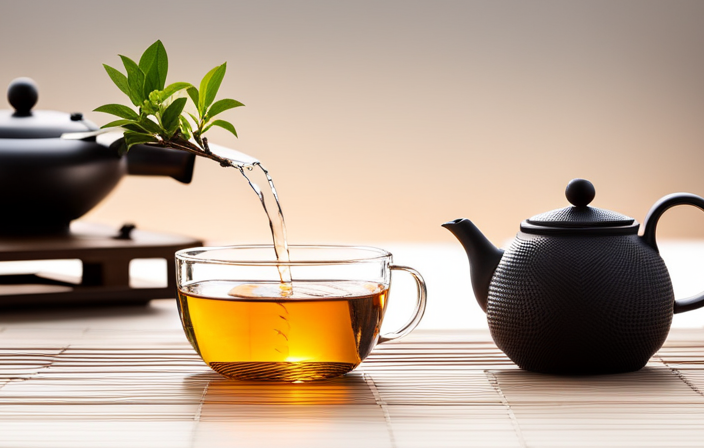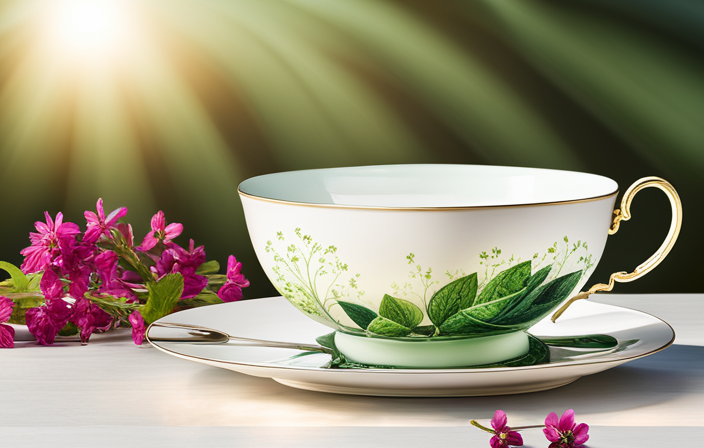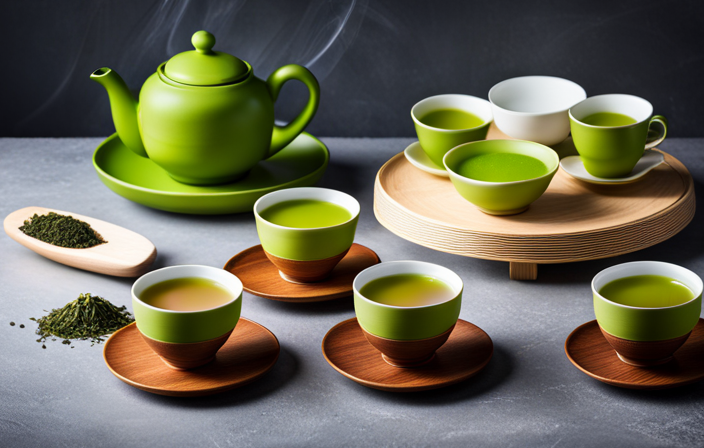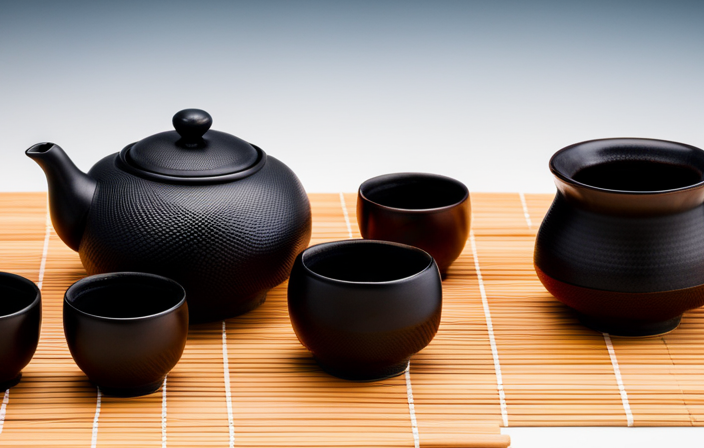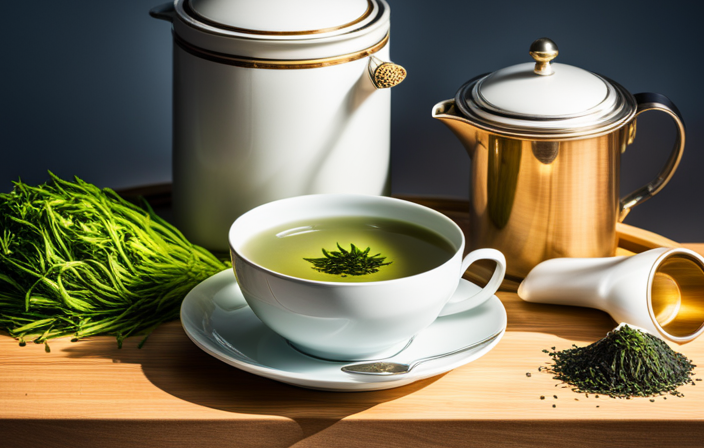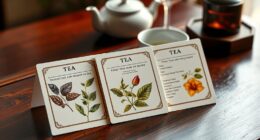Are you prepared to discover the secrets behind making the ideal cup of green tea?
Join me on a journey as we delve into the art of tea-making and discover seven essential steps to elevate your brewing skills.
From selecting the finest tea leaves to understanding the ideal water temperature, we will explore each detail that contributes to a truly exceptional cup of green tea.
Get ready to savor the rich flavors and embrace the tranquility that comes with a perfectly brewed cup.
Let’s begin our tea adventure together!
Key Takeaways
- Select high-quality green tea leaves for a delightful cup of green tea every time.
- Control water temperature within the recommended range of 160-180 degrees Fahrenheit to ensure a perfectly brewed cup with full flavor.
- Maintain the proper tea-to-water ratio of 1 teaspoon of tea leaves to 8 ounces of water for a balanced flavor profile.
- Steep green tea for the recommended time of 2-3 minutes to prevent bitterness and adjust steeping time based on personal preference.
Selecting the Right Green Tea Leaves
I’m really picky when it comes to green tea, so I always make sure to carefully select the right leaves before brewing. When it comes to tea grading, there are various factors to consider.
Firstly, the appearance of the leaves is crucial. Good quality green tea leaves should be whole, uniform in color, and free from any visible impurities.
Additionally, the aroma of the leaves is a significant indicator of their freshness and quality. The leaves should have a fragrant, grassy scent, which is a hallmark of high-quality green tea.
Lastly, I pay attention to the brewing techniques recommended for each type of green tea. Different teas require different water temperatures and steeping times to bring out their best flavors.
By selecting the right leaves and following proper brewing techniques, I can ensure a delightful cup of green tea every time.
Now, let’s move on to determining the ideal water temperature for brewing.
Determining the Ideal Water Temperature
To determine the ideal water temperature for brewing green tea, I always refer to the recommended range of 160-180 degrees Fahrenheit. Water temperature control is crucial in achieving optimal steeping and extracting the delicate flavors of green tea.
Too high a temperature can result in a bitter taste, while a temperature that’s too low may not fully unlock the tea’s potential. The ideal range allows the tea leaves to infuse with the water, releasing their complex flavors and aromas.
Achieving this optimal temperature can be done using a kettle with temperature control or by using a thermometer to gauge the water temperature. By paying attention to water temperature control, you can ensure a perfectly brewed cup of green tea that’s full of flavor and satisfaction.
Mastering the Right Tea-to-Water Ratio
When brewing green tea, it’s important to master the tea-to-water ratio to achieve the perfect balance of flavors. The tea brewing techniques greatly influence the taste and aroma of the final cup.
Green tea flavor profiles can range from delicate and grassy to bold and vegetal, so getting the ratio right is crucial. For a lighter flavor, a ratio of 1 teaspoon of loose green tea leaves to 8 ounces of water is recommended. If you prefer a stronger brew, you can increase the tea leaves to achieve a bolder taste. Experimenting with different ratios will help you find your preferred flavor profile.
Understanding the proper steeping time is the next step in creating the perfect cup of green tea.
Understanding the Proper Steeping Time
For the best results, steep your green tea for 2 to 3 minutes and then strain it carefully into your cup. This is the perfect amount of time to allow the flavors to develop without becoming too bitter.
But did you know that the water temperature can also affect the taste of your green tea? Here are a few tips to help you understand the proper steeping time and water temperature for your green tea:
- Use water that’s around 175°F (80°C) for delicate green teas, such as sencha or gyokuro.
- For bolder green teas like matcha or genmaicha, you can use slightly hotter water at around 185°F (85°C).
- Experiment with different steeping times to find your preferred flavor. Some people enjoy a shorter 1-2 minute steep for a milder taste, while others prefer a longer 3-4 minute steep for a stronger flavor.
- Don’t forget to adjust the amount of tea leaves used based on your personal preference.
Perfecting the Art of Tea Infusion
When it comes to perfecting the art of tea infusion, there are a few key points to keep in mind.
First and foremost, the water temperature plays a crucial role in extracting the flavors and aromas from the tea leaves.
Secondly, the steeping time can vary depending on the type of tea and personal preference, so it’s important to experiment and find the perfect balance.
Lastly, choosing high-quality tea leaves is essential for achieving a truly exceptional infusion.
Water Temperature Importance
I always make sure to measure the exact water temperature for brewing my green tea to achieve the perfect infusion. The temperature of the water plays a crucial role in bringing out the flavors and aromas of the tea leaves.
Here are four important points to keep in mind when it comes to water temperature effects and steeping techniques:
-
Water that’s too hot can result in a bitter and astringent taste, while water that’s too cold may not extract the full flavor of the tea.
-
Different types of green tea require different water temperatures. For delicate teas, like Japanese green teas, a lower temperature of around 160°F to 175°F is recommended. For bolder teas, such as Chinese green teas, a higher temperature of 175°F to 185°F works best.
-
It’s important to bring the water to the right temperature and then allow it to cool slightly before adding it to the tea leaves.
-
Using a thermometer or an electric kettle with temperature control can help you achieve the desired water temperature consistently.
Understanding the impact of water temperature on your green tea brewing is essential for a satisfying tea experience.
Now, let’s dive into the next section and explore the variations in steeping time.
Steeping Time Variations
To truly enhance the flavors of my green tea, I experiment with different steeping times to find the ideal balance between strength and subtlety. Steeping techniques and brewing methods play a crucial role in determining the taste and aroma of green tea. By adjusting the steeping time, I can control the intensity of the tea’s flavor profile. Too short of a steeping time may result in a weak and underwhelming brew, while steeping for too long can lead to a bitter and astringent taste. To help you understand the impact of steeping time, here’s a table showcasing the recommended steeping times for various types of green tea:
| Green Tea Type | Steeping Time (minutes) |
|---|---|
| Sencha | 1-2 |
| Matcha | N/A |
| Dragonwell | 2-3 |
| Gunpowder | 3-4 |
| Jasmine | 2-3 |
Choosing the Right Leaves
During my tea brewing journey, I’ve discovered that choosing the right leaves is essential for achieving a delightful infusion. When it comes to selecting high quality, organic leaves, there are a few key factors to consider. Here are four important points to keep in mind:
-
Understanding the different tea varieties: Each type of tea, whether it’s green, black, oolong, or white, has its own unique characteristics and flavor profiles. Understanding the differences between these varieties will help you choose the right leaves for your desired taste.
-
Leaf appearance and aroma: High quality tea leaves should have a vibrant color and a fresh, aromatic scent. Look for leaves that are whole and intact, as broken leaves can affect the flavor of the tea.
-
Origin and sourcing: Pay attention to where the tea is sourced from. Different regions have different growing conditions, which can impact the taste of the tea.
-
Organic certification: Opting for organic tea ensures that no harmful pesticides or chemicals were used during cultivation, resulting in a healthier and more environmentally friendly choice.
Enhancing Flavor With Additions and Garnishes
When it comes to enhancing the flavor of tea, additions and garnishes can make all the difference. Whether it’s a slice of lemon, a sprig of mint, or a hint of honey, these simple additions can elevate the taste and aroma of your tea.
Aromatic herbs like lavender or rosemary can also be used to infuse your tea with unique and delightful flavors. So get creative and experiment with different additions and garnishes to discover your perfect cup of tea.
Flavorful Tea Garnishes
I always love adding a slice of lemon to my tea for that extra burst of flavor. It’s amazing how a simple garnish can elevate the taste of a beverage.
When it comes to tea, there are so many flavorful options to explore. Here are some ideas to enhance your tea experience:
-
Floral Tea Pairings: Pairing floral teas like jasmine or chamomile with delicate flavors like lavender or rose can create a harmonious and aromatic blend.
-
Fruit Infused Teas: Adding fruits like berries, citrus, or tropical fruits to your tea can infuse it with a refreshing and tangy flavor.
-
Herbs and Spices: Experimenting with herbs like mint, basil, or lemongrass, or spices like cinnamon or ginger, can add depth and complexity to your tea.
-
Sweeteners: Try using natural sweeteners like honey or agave syrup to enhance the flavor of your tea without overpowering it.
By exploring these garnishing options, you can create a personalized and flavorful tea experience that will delight your taste buds.
Cheers to serving yourself and others with a perfect cup of tea!
Enhancing With Aromatic Herbs
Brewing green tea with aromatic herbs like mint or lemongrass can add an extra layer of flavor to your cup. Aromatic herb combinations are a great way to enhance the taste and aroma of your green tea.
Mint, with its refreshing and cooling properties, can provide a soothing and invigorating experience. Lemongrass, on the other hand, adds a citrusy and tangy note to your tea, giving it a zesty twist.
These herbal tea options not only elevate the taste of your green tea but also offer various health benefits. Mint aids in digestion and can help relieve headaches, while lemongrass is known for its calming effects and potential anti-inflammatory properties.
Creative Tea Infusion
Sometimes, I love experimenting with creative tea infusions by adding unique ingredients like lavender or ginger. It’s amazing how a simple addition can transform a regular cup of tea into a delightful and refreshing experience. If you’re looking to spice up your tea routine, here are some ideas to try:
-
Mint and lemon: Add a sprig of fresh mint and a squeeze of lemon to your green tea for a zesty and invigorating blend.
-
Peach and basil: Infuse your tea with slices of fresh peach and a few basil leaves for a sweet and herbaceous twist.
-
Vanilla and cinnamon: Enhance your tea with a touch of warmth by adding a vanilla bean and a cinnamon stick.
-
Hibiscus and orange: Create a vibrant and tangy tea cocktail by combining hibiscus flowers and orange slices.
These unique tea blends are perfect for serving others and will surely impress your guests with their creative flavors. So go ahead, unleash your inner mixologist and enjoy the endless possibilities of creative tea infusions!
Storing and Preserving Green Tea for Freshness
I always store my green tea in an airtight container to maintain its freshness. Storing methods play a crucial role in preserving the delicate flavors and aroma of green tea.
One of the primary concerns when storing green tea is preventing oxidation. Oxidation can lead to a loss of flavor and quality. To prevent this, it’s essential to keep the tea leaves away from moisture, light, and air. By storing green tea in an airtight container, we can minimize its exposure to these elements.
Additionally, it’s advisable to store green tea in a cool, dry place, away from strong odors. This helps to maintain the natural characteristics of the tea leaves and ensures a delightful tea-drinking experience.
Frequently Asked Questions
Can I Use Any Type of Water to Brew Green Tea?
Yes, you can use any type of water to brew green tea. However, the quality of water is important for the best flavor. Different types of water can affect the taste and aroma of the tea.
How Long Does Green Tea Stay Fresh After It Is Opened?
Green tea stays fresh for about 6-12 months after opening, depending on how it’s stored. To extend its shelf life, store it in an airtight container in a cool, dry place away from sunlight.
Can I Reuse Green Tea Leaves for Multiple Infusions?
Yes, you can reuse green tea leaves for multiple infusions. By doing so, you can extract different flavors and aromas from the leaves, while still enjoying the health benefits of green tea.
Does the Quality of the Water Affect the Taste of Green Tea?
Yes, the quality of the water does affect the taste of green tea. Using water at the right temperature and steeping time is crucial. Did you know that using filtered water can enhance the flavors even more?
Are There Any Health Benefits Associated With Drinking Green Tea?
Drinking green tea has numerous health benefits, including aiding in weight loss. It is packed with antioxidants that boost metabolism and promote fat burning. Regular consumption can contribute to overall well-being.
Conclusion
In conclusion, by following these 7 steps, you can perfect your green tea brewing and enjoy a delicious cup every time.
Did you know that green tea is the second most consumed beverage in the world after water? Its popularity isn’t surprising, considering its numerous health benefits and refreshing taste.
So, why not take the time to master the art of brewing green tea and elevate your tea-drinking experience?
Cheers to a perfect cup of green tea!

